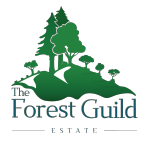
We were warned that deer could wreak havoc and eat our plants but, of course, I was only listening with one ear open. After all, I love deer and want to see them frolicking on the property. But, did you know that if you plant hundreds–and I mean HUNDREDS–of strawberry plants over a weekend, they might be gone in the next couple of days? This is what happened to me. It made my excitement for deer wane…but only slightly! So here is a post about the deer we find on our property and the deer you may even find in your backyard throughout British Columbia.
(By the way, I was assigned a presentation on the Black-Tailed Deer for my Red Seal Landscape Horticulture program at Kwantlen University. So this blog is actually part of my homework…I am essentially killing two birds with one stone!)
In British Columbia we have 3 types of deer: the white-tailed deer, the mule deer and the black-tailed deer.
Both the mule and the black-tailed deer are in the:
GENUS: Odocoileus | SPECIES: hemionus | FAMILY: Cervidae |ORDER: Artiodactyla.
IDENTIFY: Black-Tailed Deer mainly travel alone or in small groups of three or four. These groups are usually a family made up of mom (a doe), her current babies, as well as her offspring from the previous year (fawns).
The black-tailed deer are about 1-meter tall at the shoulder and weigh 35- to 110-kilograms. The bucks (males) have antlers, that begin to grow in the spring and they lose them each fall. The deer are brown, with large ears and black tails. The fawns have white dots all over which helps them camouflage.
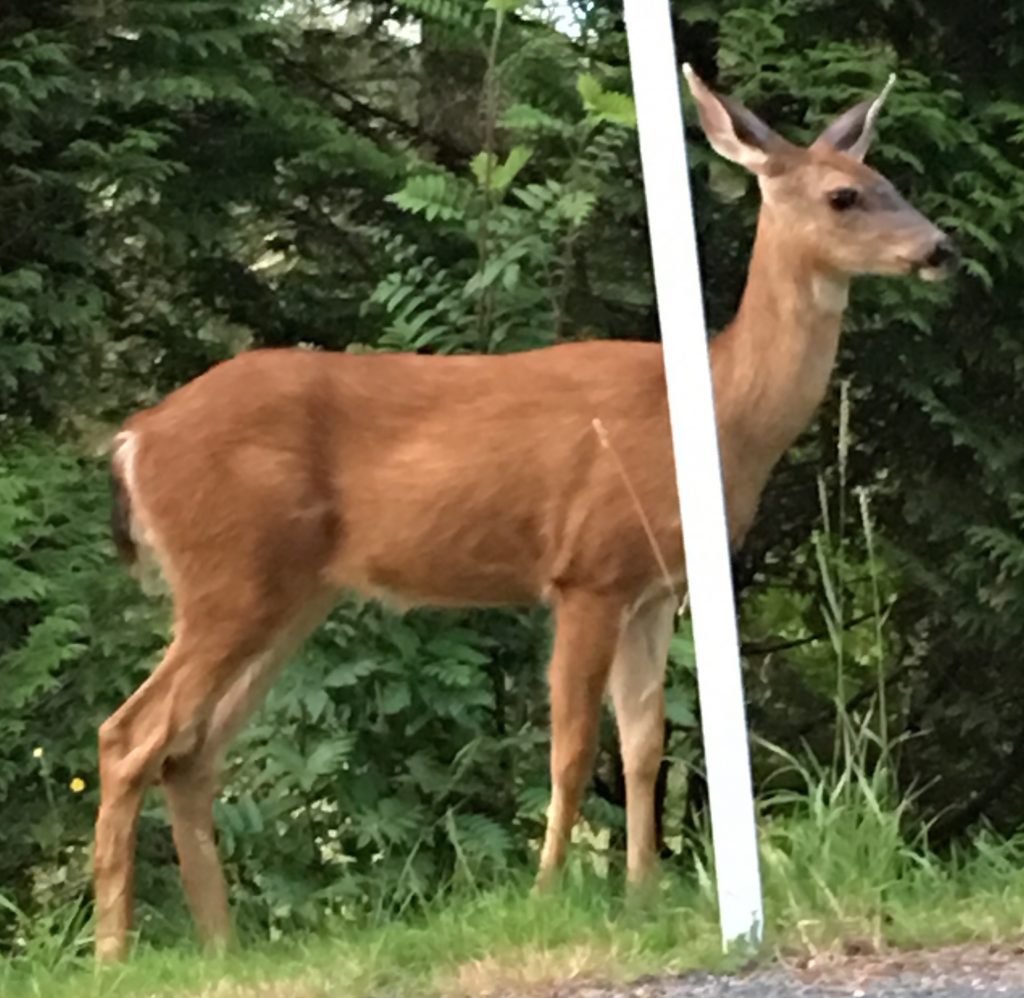
LIFECYCLE: In the late fall, deer go ‘into the rut’. This means it is breeding season! In fact, it is deer breeding season right now (mid November). The deer breeding season is triggered by the shorter days (what else are they going to do in the dark?). Upon mating success, the gestation period is approximately 200 days resulting in the does having their babies in June. Most of them have twins. The overall lifespan of the deer ends up being somewhere between 8 and 10 years.
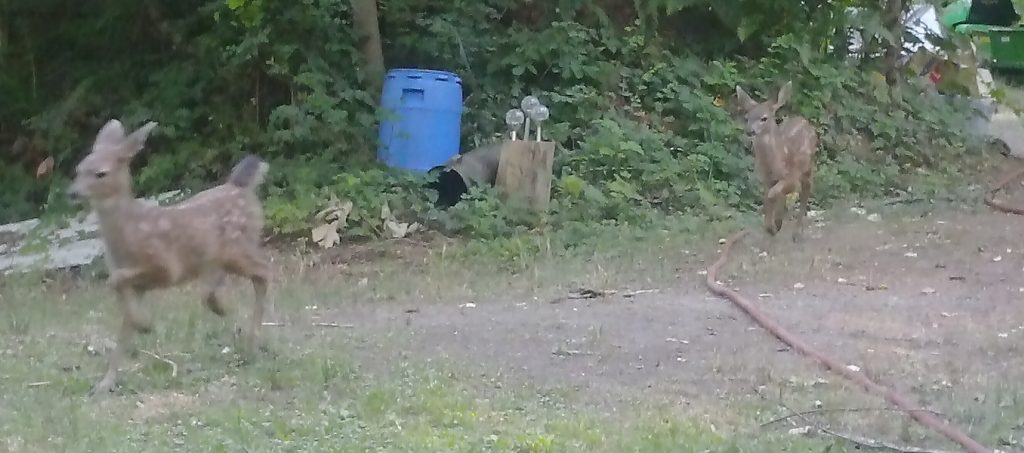
FOOD: Deer are grazers and browsers (we have a lot in common) and their meals consist of grasses, shrubs and woody plants. They really love to eat the new growth in the spring and bark and buds in the winter.
EXPLANATION OF HOW RUMINANT ANIMALS DIGEST:
Deer are a ruminant animal which means they have four stomach compartments. As a nutritionist, one of the first things I tell my clients is: slow down and chew your food. Deer do NOT follow this tip. In fact, they eat very fast and only chew enough so that the food can fit down the hatch.
Compartment 1: The Rumen
Upon swallowing, the food goes down into the first of the four stomach compartments. This first compartment is called the rumen. The rumen is like a storage center that, once filled, sends the food back up again for a second round of chewing. On this second round, the food gets properly chewed. This is where the lovely term ‘chewing their cud’ comes from (also known as ‘ruminating’).
Compartment 2: The Reticulum
Once the deer have finally broken the food down into smaller pieces, they swallow it (again) and it goes down to the second chamber: the reticulum. The reticulum is filled with microorganisms which help break down or “ferment” the food. This compartment really helps break down the cellulose (plant wall material.) As humans, we refer to this as ‘eating our ruffage’, as we can’t properly digest it. However, it’s great to get things moving, if you know what I mean! Believe it or, they bring it back up a third time to, chew it again before moving it to the next chamber.
Compartment 3: The Omasum
The third chamber is the omasum. This is where water is absorbed from the chewed food.
Compartment 4: The Abomasum
Finally, what’s left of the food is moved is moved to the last chamber: the abomasum. This chamber is the most similar to ours and is where all the gastric juices are found. From this chamber, everything flows through the intestines where the nutrients are absorbed and the waste is passed through in the form of deer droppings/scat. In fact, you may have seen their pellet-like deer poop yourself (it looks similar to rabbit poop).
HABITAT: Black-tailed deer are found on our property in Columbia Valley as well as along our coast and in our alpine and rainforest habitats here in BC. The deer are often seen in meadows and walking across the road. They change locations throughout the season depending on how much protection they need at the time. In the winter they really need to be protected, so large trees with a big canopy and thickets are an ideal location.
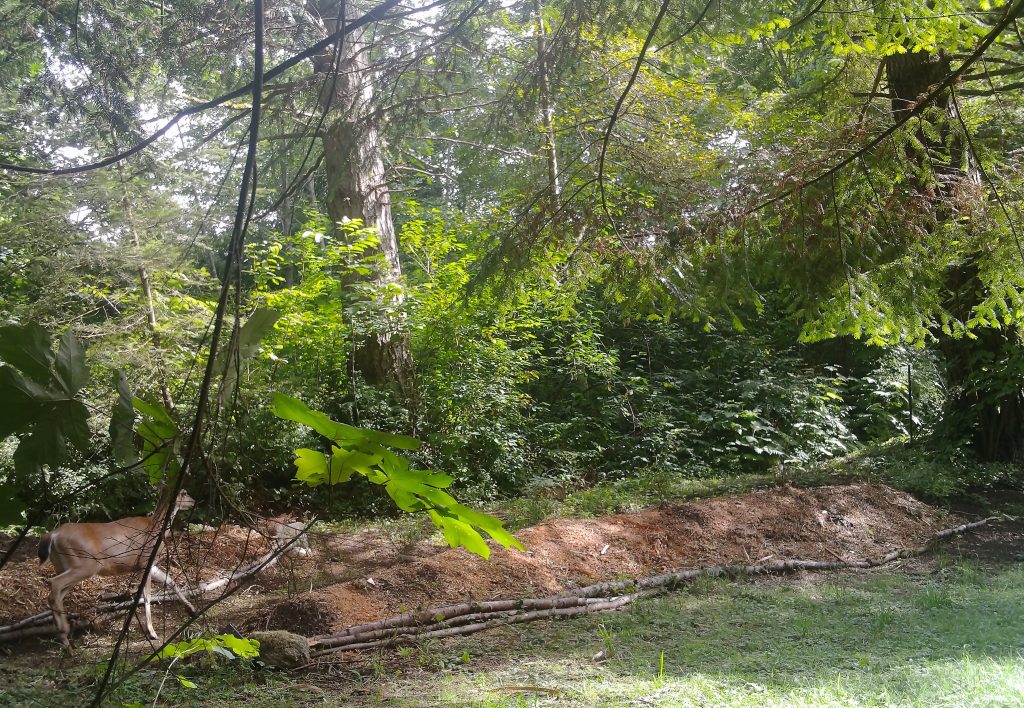
THREATS: Deer may be large but they are prey animals. An easy way to identify prey animals is by eye placement on the sides of their heads. With eyes located on the side, prey animals have great peripheral viewing so they can continually look for predators. Here in BC, deer are often hunted by cougars, coyotes, bears and humans. They are also threatened by parasites. Another threat factor is habitat loss, or harsh winters (again, we have a lot in common!).
CONTROL METHODS: As I said above, deer are majestic creatures but they will destroy whatever you want to keep in your garden. So, how can you keep them out? The best way is a fence. BUT not a 6-foot fence–they will just leap right over that one. You need a very high fence: the higher the better. I’ve been told the best fence height to protect your garden from deer is at least 9-10 feet tall.
Unfortunately a 9-10 foot fence would be extremely expensive to go around an entire acreage. So, I am going to try other ways to fend off the deer, such as lavender. Did you know that deer don’t like the smell of it on their skin? There are other plants that are deer resistant, so I’ll try planting some of those as well. I’ve also read that people also hang old CDs or tin cans in trees to create sights and sounds that make the deer nervous to be there.
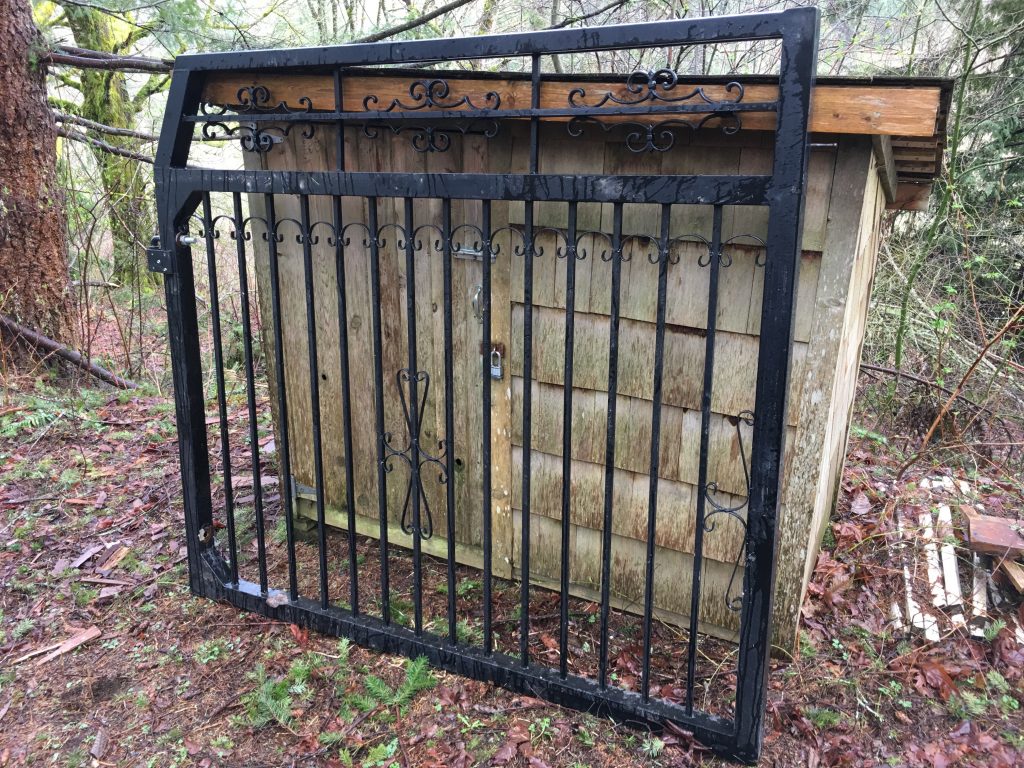
What’s your verdict on deer? Have you seen them in your garden lately? How do you keep them out?
Becky is a Clinical Hypnotherapist, Registered Holistic Nutritionist, Landscape & Production Horticulturist, Arborist and budding Herbalist, who recognizes and specializes in the link between healthy soil, the gut and the brain. She also loves being the mom to her two wild and crazy kids Brooke & Connor whom keep her and her ever loving, creative husband Jay on their toes.
Becky is a Clinical Hypnotherapist, Registered Holistic Nutritionist, Landscape & Production Horticulturist, Arborist and budding Herbalist, who recognizes and specializes in the link between healthy soil, the gut and the brain. She also loves being the mom to her two wild and crazy kids Brooke & Connor whom keep her and her ever loving, creative husband Jay on their toes.
Design by NXNW.
Ithfifi
January 28, 2018 at 7:59 pmThis is so interesting, I had no idea deers ate so much! Do you find it to be a problem? They are such beautiful and elegant creatures, it must be amazing to see them so close up, what an amazing place to live!
Becky
January 29, 2018 at 1:20 amThanks so much! I love living alongside deer, but yep, they can be an absolute menace. They ate so much of our food last year. One day I hope that we have enough to share. Last year the bears ate every apple, and the bears are more concerning.
Frank Herrmann
September 27, 2023 at 7:36 pmOur back yard is surrounded by a 5’ high wood fence and deer do not jump that, we plant that with anything we like. Our front is unfenced and only plant native or plants that have been proven deer resistant mostly plants with yellow flowers. They don’t care what color a rose is they eat them all.